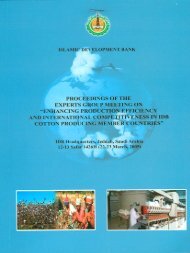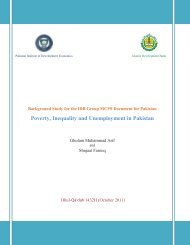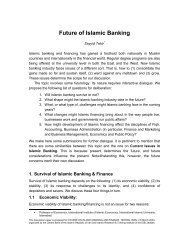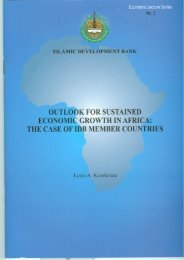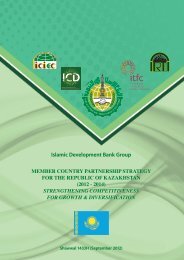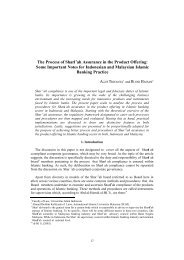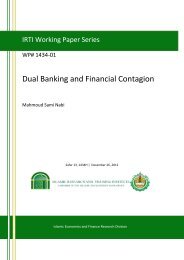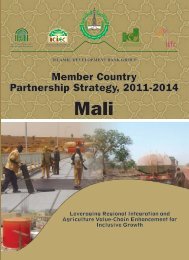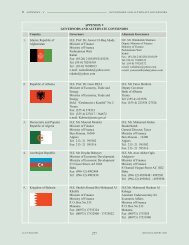35th 1430H - Islamic Development Bank
35th 1430H - Islamic Development Bank
35th 1430H - Islamic Development Bank
You also want an ePaper? Increase the reach of your titles
YUMPU automatically turns print PDFs into web optimized ePapers that Google loves.
ACHIEVING ECONOMIC RECOVERYthe population in many developing countries is in theinformal sector and self-employed; and do not havesocial protection. Estimates show that countries withabove average sized informal economies are more thanthree times as likely to suffer the adverse effects of acrisis (higher cyclical volatility) as those with lowerrates of informality 16 .ILO recommends that governments all over the worldcontinue their fiscal stimulus packages taking intoaccount the principles of “Global Jobs Pact”, whichprioritizes employment and social protection in theprocess of economic recovery 17 . In this context, bothdeveloped and developing countries need to re-orienttheir growth strategies and place employment and socialprotection at the centre of global economic recoverywhich may require focusing on: (i) maintaininginvestments in infrastructure; (ii) supporting small andmedium-size enterprises and microfinance and; (iii)enhancing social safety net programs to protect themost vulnerable.Climate Change: Climate change is the greatestenvironmental challenge facing the world today andwill clearly remain on top of the global developmentagenda for many years. While climate change is aglobal phenomenon, its negative impacts are moreseverely felt by low income countries. The costs ofclimate change are expected to be huge. According tothe Stern Report, if the world does not act, the overallcosts and risks of climate change will be equivalent tolosing at least 5 percent of global GDP each year. Incontrast, the costs of action – reducing greenhouse gasemissions to avoid the worst impacts of climate change– can be limited to around 1 percent of global GDPeach year 18 .A successful global response to climate change callsfor partnership between developing and developedcountries to address the two major issues required totackle climate change: (i) adaptation which addressesthe consequences of climate change. The question is,now that global warming is happening, how we canmake societies better able to cope with an uncertainfuture and; (ii) mitigation which addresses the causesof climate change and poses the question as to howindividuals and industries can change their practices tohalt the process of global warming.16Bacchetta, Ernst and Bustamante, 2009.17Global Jobs Pact is a program adopted in the Jobs Crisis Summit organizedby ILO in Geneva on 15-17 June 2009. The strategic objective of the GlobalJobs Pact is to place employment and social protection at the centre of recoverypolicies in order to accelerate employment recovery, ensure inclusive access toemployment through specific measures for disadvantaged groups, broaden thecoverage of social protection and enhance security.18The Economics of Climate Change (2007), Nicholas Stern Cabinet Office -HM Treasury, UK.In 2009, climate change was included in the agenda ofseveral important international and regional meetings.During the 2009 Annual Meetings of the World <strong>Bank</strong>/IMF in Turkey, the world development communityemphasized that the global economic crisis must notdistract the policy makers from tackling the crucialissue of climate change. On 2 nd December 2009, theHeads of MDBs on their joint statement reiteratedtheir commitments to (i) assist developing countries totake climate change issues on board in their economicplanning and management at both national and regionallevels and to (ii) ensure that the world economydevelops along a sustainable greenhouse gas emissionspathway.In December 2009, world leaders gathered inCopenhagen, Denmark, to thrash out a successor tothe Kyoto Protocol 19 . The participants focused on thefollowing four main areas: (i) the level of mid-termemission reduction targets that industrialized countrieswill commit; (ii) the actions that developing countriescould undertake to limit their greenhouse gas emissions;(iii) definition of stable and predictable financing tohelp the developing countries reduce greenhouse gasemissions and adapt to the impacts of climate changeand; (iv) identification of institutions that will allowtechnology and finance to be transferred to developingcountries. They agreed to provide short-term finance tothe tune of $10 billion a year over three years to poorcountries to help them fight climate change, and a longterm funding package worth $100 billion a year by2020 20 .In line with other MDBs, IDB works closely with itsmember countries, especially low-income countries,to assist them in their national efforts to climate-proofMDGs, through the formulation and implementationof effective national adaptation programs, includingwater-food security and disaster risk management.On the mitigation front, IDB mainly focuses on (i)improving energy efficiency; and (ii) clean energydevelopment such as hydropower, solar energy andwind power.19The Kyoto Protocol was adopted in Kyoto, Japan, on 11 December 1997and entered into force on 16 February 2005. The major feature of the KyotoProtocol is that it sets binding targets for 37 industrialized countries and theEuropean community for reducing greenhouse gas (GHG) emissions. TheProtocol committed developed countries to reducing their greenhouse gasemissions by 5.2 percent in relation to 1990 levels by 2008-2012. That targethas not been achieved. Emissions from these countries, including the US whichdid not ratify the Protocol, fell by 4.3 percent between 1990 and 2007. It is alsoestimated that global greenhouse gas emissions increased by 22 percent.20House of Commons Library, Climate Change: The Copenhagen Conference,Research Paper 09/87, 2 December 2009.20IDB ANNUAL REPORT <strong>1430H</strong>






